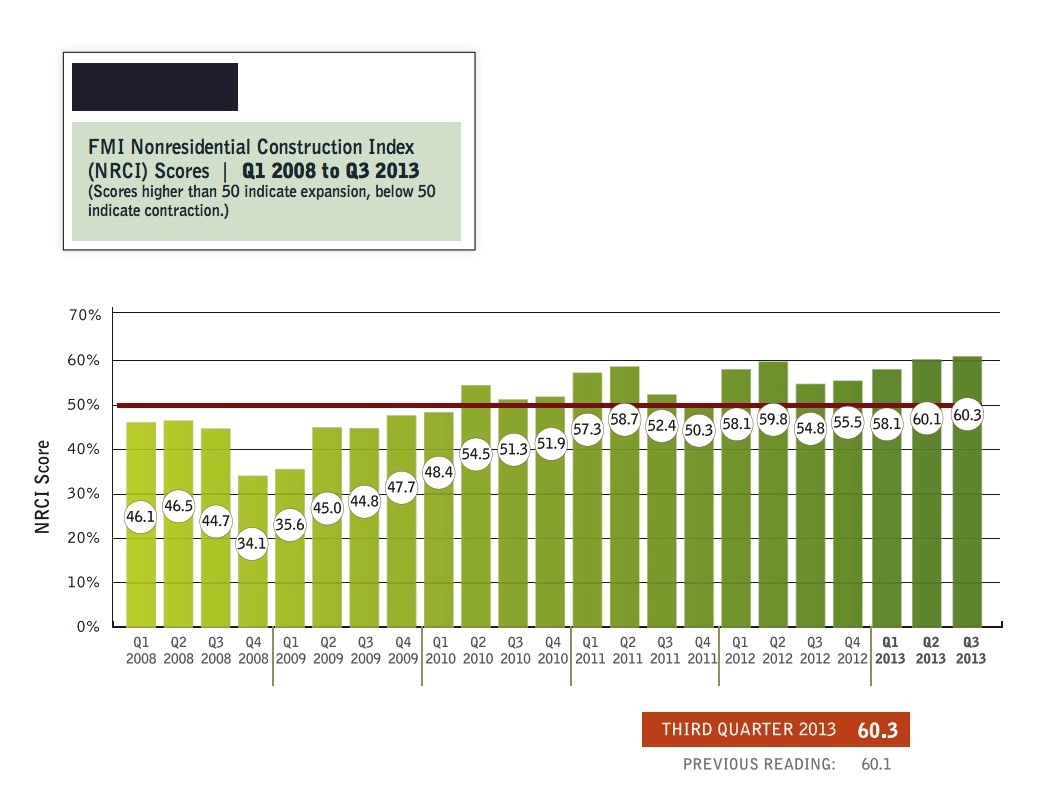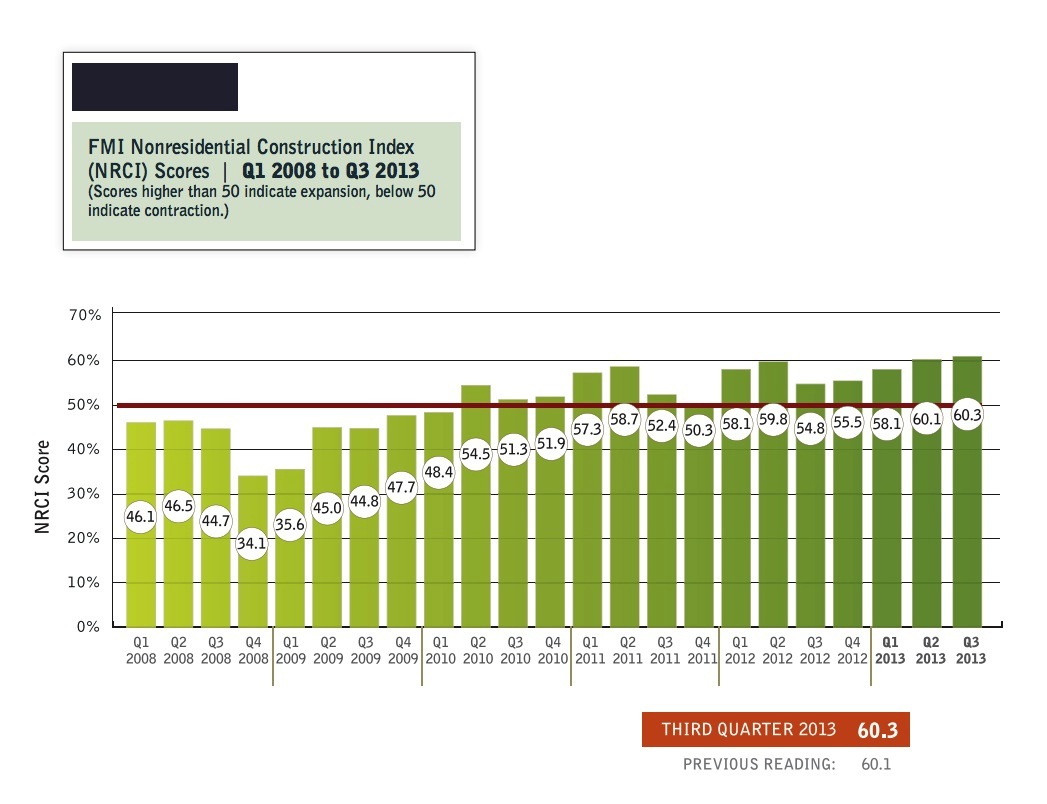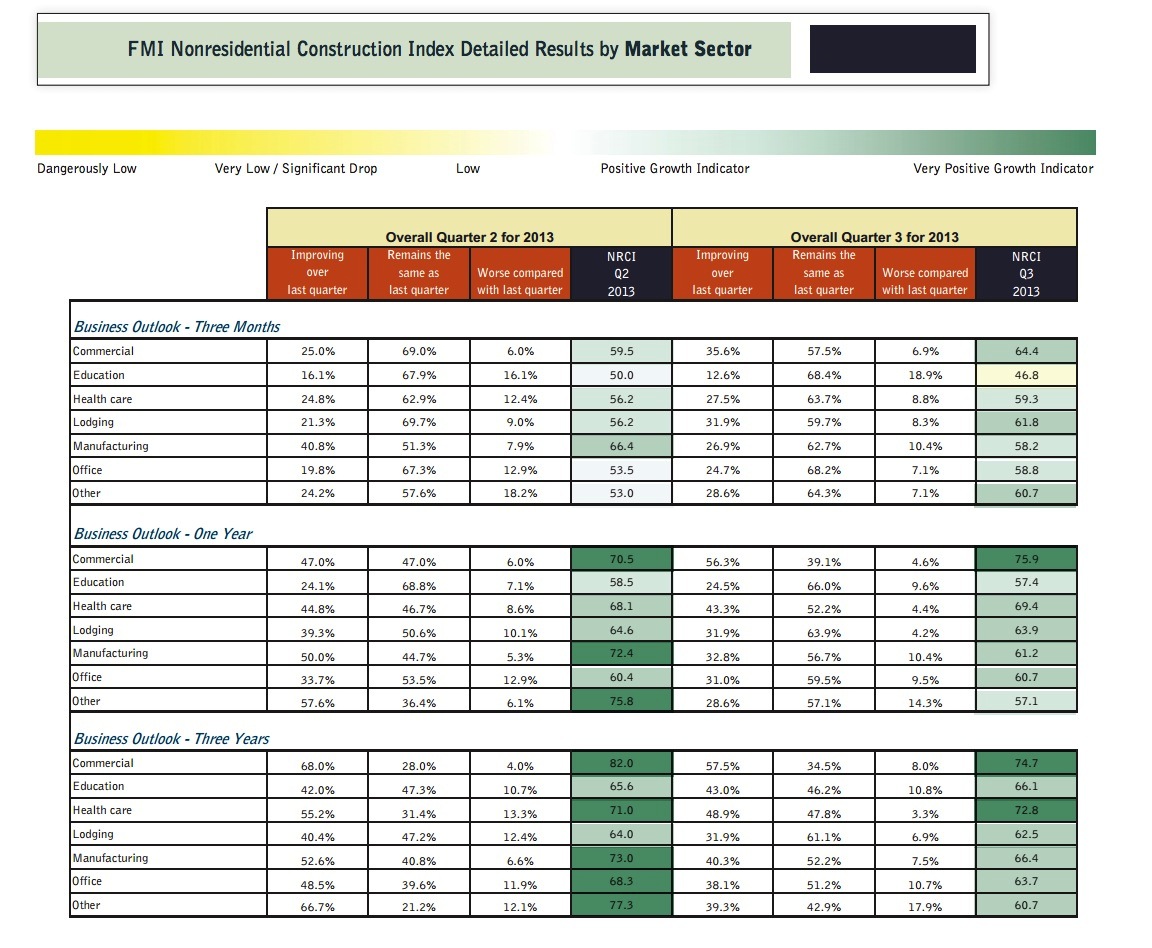FMI's 2013 Third Quarter Nonresidential Construction Index report shows a NRCI score of 60.3, a .2-point improvement over Q2.
Although the numbers aren’t drastically rising, the sustainability and continuing upward movement is encouraging. This score remains the highest score for the NRCI index since Q1 2009. The index for the overall economy rose to 72 points and the combined index sentiment for economies where panelists are doing business rose 3.2 points.
Cost of construction materials, cost of labor and productivity continue to hold down the index. Additionally, investments in technology, equipment and training are needed to keep the economy from going stagnant.
Panelists for this quarter’s NRCI suggest that the uncertainty for investments is a result of the immigration/labor bills, delays in implementation of “Obamacare” and the impact of residential growth on nonresidential construction. These issues are causing the industry to sit back and wait to see the outcomes before making any risky investments.
To download a copy of the full report, click here.
CLICK CHARTS TO ENLARGE
About FMI
FMI is a leading provider of management consulting, investment banking and research to the engineering and construction industry. We work in all segments of the industry providing clients with value-added business solutions. Founded by Dr. Emol A. Fails in 1953, FMI has professionals in offices across the U.S. FMI delivers innovative, customized solutions to contractors; construction materials producers, manufacturers and suppliers of building materials and equipment, owners and developers, engineers and architects, utilities, and construction industry trade associations. FMI is an advisor you can count on to build and maintain a successful business, from your leadership to your site managers. For more information, visit www.fminet.com.
Related Stories
Codes and Standards | Jul 17, 2023
Outdated federal rainfall analysis impacting infrastructure projects, flood insurance
Severe rainstorms, sometimes described as “atmospheric rivers” or “torrential thunderstorms,” are making the concept of a “1-in-100-year flood event” obsolete, according to a report from First Street Foundation, an organization focused on weather risk research.
Multifamily Housing | Jul 13, 2023
Walkable neighborhoods encourage stronger sense of community
Adults who live in walkable neighborhoods are more likely to interact with their neighbors and have a stronger sense of community than people who live in car-dependent communities, according to a report by the Herbert Wertheim School of Public Health and Human Longevity Science at University of California San Diego.
Contractors | Jul 13, 2023
Construction input prices remain unchanged in June, inflation slowing
Construction input prices remained unchanged in June compared to the previous month, according to an Associated Builders and Contractors analysis of U.S. Bureau of Labor Statistics Producer Price Index data released today. Nonresidential construction input prices were also unchanged for the month.
Government Buildings | Jul 13, 2023
The recently opened U.S. Embassy in Ankara reflects U.S. values while honoring Turkish architecture
The U.S. Department of State’s Bureau of Overseas Buildings Operations (OBO) has recently opened the U.S. Embassy in Ankara, Turkey. The design by Ennead Architects aims to balance transparency and openness with security, according to a press statement. The design also seeks both to honor Turkey’s architectural traditions and to meet OBO’s goals of sustainability, resiliency, and stewardship.
Affordable Housing | Jul 12, 2023
Navigating homelessness with modular building solutions
San Francisco-based architect Chuck Bloszies, FAIA, SE, LEED AP, discusses his firm's designs for Navigation Centers, temporary housing for the homeless in northern California.
Sponsored | Fire and Life Safety | Jul 12, 2023
Fire safety considerations for cantilevered buildings [AIA course]
Bold cantilevered designs are prevalent today, as developers and architects strive to maximize space, views, and natural light in buildings. Cantilevered structures, however, present a host of challenges for building teams, according to José R. Rivera, PE, Associate Principal and Director of Plumbing and Fire Protection with Lilker.
Building Owners | Jul 12, 2023
Building movement: When is it a problem?
As buildings age, their structural conditions can deteriorate, causing damage and safety concerns. In order to mitigate this, it’s important to engage in the regular inspection and condition assessment of buildings for diagnosis.
Mass Timber | Jul 11, 2023
5 solutions to acoustic issues in mass timber buildings
For all its advantages, mass timber also has a less-heralded quality: its acoustic challenges. Exposed wood ceilings and floors have led to issues with excessive noise. Mass timber experts offer practical solutions to the top five acoustic issues in mass timber buildings.
Multifamily Housing | Jul 11, 2023
Converting downtown office into multifamily residential: Let’s stop and think about this
Is the office-to-residential conversion really what’s best for our downtowns from a cultural, urban, economic perspective? Or is this silver bullet really a poison pill?
Adaptive Reuse | Jul 10, 2023
California updates building code for adaptive reuse of office, retail structures for housing
The California Building Standards Commission recently voted to make it easier to convert commercial properties to residential use. The commission adopted provisions of the International Existing Building Code (IEBC) that allow developers more flexibility for adaptive reuse of retail and office structures.




















